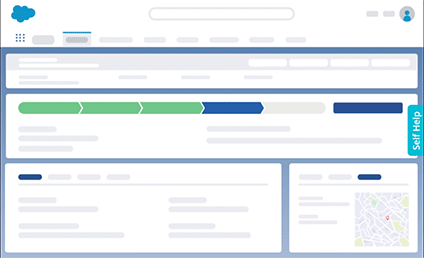The Role of AI in Digital Transformation (2024)
- Published:
- Updated: April 1, 2024

Digital transformation impacts business success across all industries, signifying a shift towards leveraging new technologies and becoming more digitally mature to enhance productivity, efficiency, and effectiveness.
This evolution is not just about adopting new technologies—it’s about fundamentally transforming business operations and strategies to thrive in the digital era.
At the heart of this transformative wave lies the integration of artificial intelligence (AI), which has reshaped how businesses approach their digital transformation roadmaps. AI’s impact on cloud transformation and the broader AI transformation initiative is becoming increasingly pivotal, offering unprecedented opportunities to innovate and gain competitive advantages.
What Is Digital Transformation?
Digital transformation refers to incorporating digital technology into all aspects of a business, fundamentally changing how operations are conducted and how value is delivered to customers.
It extends beyond simply automating existing processes with new cloud software like ERP systems, CRM software, and financial tools. It encompasses leveraging cutting-edge technologies such as blockchain, robotics, the Internet of Things (IoT), and notably, AI to drive business transformation.
Generative AI is increasingly important in digital transformation. With its ability to create content and solutions that were otherwise unimaginable, generative AI is not just enhancing existing processes but is paving the way for new forms of innovation and creativity in the digital space.
The inception of digital transformation can be traced back to the 1990s, starting with basic technologies like spreadsheets and word processors, and evolving into sophisticated enterprise software. The 2000s witnessed a surge in disruptive technologies such as blockchain, AI, predictive analytics, and virtual reality, marking a significant leap towards digital transformation.
The COVID-19 pandemic highlighted the need for digital preparedness, with 85% of executives accelerating the adoption of digital technologies for remote work and business continuity. This period demonstrated the critical role of AI in enabling businesses to adapt swiftly to changing circumstances and maintain operational resilience.
Business leaders recognize the value of digital transformation in enhancing operational efficiencies, reducing time to market, and meeting evolving customer expectations. Market intelligence firm IDC predicts that by 2026, 75% of business leaders will embrace digital innovations to bolster profitability.
The essence of successful digital transformation lies in a company’s vision for its future post-transformation rather than the technology itself. It requires a holistic understanding and acceptance of new technologies across the workforce. Developing a change management framework that communicates roles, responsibilities, and the strategic vision is essential for facilitating a positive organizational change, with AI playing a pivotal role in shaping the future of digital initiatives.
AI’s Impact on Cloud Transformation
Integrating AI with cloud computing revolutionizes cloud services, providing unparalleled benefits to businesses. This transformation is defined by increased efficiency, improved security measures, and innovative services that leverage AI’s analytical and predictive capabilities.
Here are some ways AI is driving cloud transformation:
1. Enhanced cloud security
AI has significantly improved cloud security measures. AI systems can use advanced machine learning algorithms to analyze patterns and predict potential security threats. This ensures swift and automated responses, revolutionizing how cloud services manage and mitigate risks.
Some examples of this include:
- Automated threat detection: AI algorithms continuously monitor cloud environments to detect and analyze threats in real-time, significantly reducing the window for potential damage.
- Anomaly detection: By learning normal network behavior, AI can identify deviations that may indicate a security breach, enabling immediate investigation and response.
- Predictive security measures: AI tools can forecast potential vulnerabilities by analyzing trends and patterns, allowing for preemptive security hardening and risk reduction.
The application of AI in cloud security enhances protection, facilitates compliance with regulatory requirements, and safeguards sensitive data against potential threats.
2. Optimized cloud resources
AI’s predictive and analytical capabilities are crucial in optimizing cloud resources, ensuring that cloud environments operate efficiently and cost-effectively. With intelligent data analysis, AI can forecast demand, allocate resources dynamically, and enhance overall system performance.
Here are some ways AI optimizes cloud resources and performance:
- Dynamic resource allocation: AI-driven systems analyze current demand and predict future requirements, adjusting resources in real time to meet workload demands without over-provisioning.
- Cost optimization: By continuously monitoring resource usage, AI identifies and eliminates inefficiencies, helping businesses minimize cloud spending while maximizing performance.
- Automated scaling: AI enables automated scaling of resources to handle peak loads, ensuring that applications remain responsive and available without manual intervention.
3. AI-powered analytics and insights
Cloud-based AI analytics transform large amounts of data into actionable insights, enabling businesses to make data-driven decisions. These AI capabilities allow for real-time processing and analysis, offering a competitive edge in rapidly changing market conditions.
Examples of AI-powered analytics and insights include:
- Real-time data processing: AI tools can analyze and process data as it’s collected, providing immediate insights for timely decision-making.
- Predictive analytics: Leveraging historical data, AI can predict trends and outcomes, helping businesses to strategize and plan for future scenarios.
- Personalized customer experiences: AI analyses customer behavior and preferences, allowing businesses to offer personalized services and products, enhancing customer satisfaction and loyalty.
The convergence of AI and cloud computing in analytics empowers businesses with deep insights, fostering innovation and strategic growth.
4. Intelligent automation and DevOps
AI enhances DevOps practices by introducing automation into the continuous integration and deployment pipeline (CI/CD), improving software development processes, and operational efficiency. This integration facilitates a more agile development environment, where deployment can be accelerated and made more reliable.
- Automated code testing: AI tools can automatically test and validate code, identifying errors and vulnerabilities faster than manual processes.
- Continuous monitoring: AI-enabled monitoring tools provide real-time insights into application performance and user experience, allowing for immediate adjustments.
- Efficient problem resolution: AI algorithms can predict potential system failures or bottlenecks and suggest solutions, often before the problem impacts the user.
Incorporating AI into DevOps speeds up the development cycle and ensures higher quality and reliability of software deployments, enabling businesses to deliver superior products and services to their customers.
5. Enabling employees to maximize productivity and efficiency
Generative AI (genAI) is making strides in enhancing workplace efficiency and employee productivity through its multifaceted applications:
Better Knowledge Discovery:
- GenAI tools streamline access to essential information, such as documentation and best practices, enabling quick, informed decision-making. This reduces the time employees spend on searches, leading to higher productivity.
- These tools understand query context, offering precise answers and eliminating the need for employees to sift through irrelevant information.
Writing Better Content:
- GenAI assists in creating a wide range of written content, from internal communications to marketing copy, by synthesizing key themes and generating coherent drafts. This process not only saves time but also ensures consistency across various types of communications.
- It also enhances content quality by suggesting improvements, maintaining a consistent brand voice, and ensuring grammatical accuracy.
Accomplishing Tasks and Overcoming Technical Challenges:
- For data-intensive tasks, genAI helps analyze large datasets to extract actionable insights, aiding in more strategic business decisions without requiring deep technical expertise.
- It can generate simple code for automating tasks, allowing employees with minimal coding knowledge to solve technical problems efficiently, thereby enabling a broader range of staff to contribute to technical projects and innovations.
By leveraging genAI for information retrieval, content creation, and technical solutions, businesses can enhance operational efficiency, foster innovation, and maintain a competitive edge in the digital era. This strategic adoption of genAI serves as a key driver in the ongoing journey of digital transformation, streamlining processes and empowering employees to achieve their full potential.
Business Processes Being Transformed by AI
Digital transformation is largely powered by AI, which encompasses digital innovations like machine learning (ML), deep learning, natural language processing (NLP), and predictive analytics. Each of these technologies helps enterprise systems become smart enough to analyze data, anticipate trends, and automate routine tasks.
As we embrace these capabilities, the emergence of ChatGPT in 2023 has further revolutionized our understanding and application of AI, demonstrating its potential to enhance customer interactions, content generation, and operational efficiency in unprecedented ways. Organizations are no longer questioning whether or not to use AI but how to leverage its evolving capabilities.
This change in perspective is underscored by the rapid adoption rates, with 50% of businesses reporting they have integrated AI into at least one business function. According to an IDC survey, 75% of respondents have plans to digitally transform their operations by 2025, indicating a broad understanding of the importance of AI in shaping the future of business.
The introduction of AI platforms like ChatGPT signifies a pivotal shift, illustrating AI’s growing sophistication and ability to change workplace dynamics. This advanced AI model has expanded the possibilities for automating complex tasks and opened new avenues for innovation, enabling businesses to explore new customer service, content creation, and process automation approaches.
The impact of ChatGPT and similar technologies is a clear testament to the transformative power of AI, urging companies to reconsider their digital transformation strategies in light of these developments.
1. Customer service
AI hugely enhances customer service by categorizing cases, providing personalized recommendations, and utilizing chatbots to deliver an intuitive experience.
Here are a few examples of how AI transforms customer service:
- Smart case classification tools: Tools like Einstein Classification Apps route customer inquiries to relevant support channels, enabling support agents to resolve cases more efficiently, accurately, and consistently. This leads to higher customer satisfaction scores (CSAT), saves time for agents, and improves the overall customer experience by streamlining the tracking, solving, and automation of customer service processes.
- AI recommendation engines: Engines like Amazon’s recommendation algorithm utilize customer data to cross-sell and up-sell related products effectively. This enhances customer re-engagement, increases website traffic with personalized ads, and helps shoppers find what they need swiftly and conveniently.
- Chatbots and conversational AI: Advanced conversational AI bots like Siri, Alexa, and Google Assistant assist customers with routine inquiries. By quickly resolving customer issues, AI-powered chatbots save companies approximately eight billion dollars, reduce operating and hiring expenses, and enhance the user experience with speedier and more accurate service.
- Customer authentication and warranty verification: AI can authenticate customers’ identities and verify product warranties, streamlining the process of securing services and claims. This use of AI enhances security and trust, ensuring a smoother, more reliable customer service experience.
- Emotion analytics for customer attitude analysis: Using emotion analytics (EA), companies can analyze customers’ sentiments and emotional responses to address issues more effectively. This enables businesses to tailor their customer service and product offerings, improving engagement and satisfaction.
- Proactive issue resolution through NLP: Natural language processing (NLP) allows companies to proactively identify and address customer issues before they escalate. By analyzing customer communication and feedback, NLP technologies can detect potential problems and initiate solutions, enhancing customer service responsiveness.
- Call center transformation with computer vision: Integrating computer vision into call centers transforms how customer interactions are managed, allowing for real-time document verification, facial recognition for identity verification, and enhanced security measures. This technology streamlines operations and provides a more personalized and secure customer experience.
- Enhanced CRM insights and agent training: AI technologies offer advanced insights into customer behavior and preferences, improving CRM systems. These insights enable more effective agent training programs, equipping customer service representatives with the knowledge and skills to meet customer needs more effectively and efficiently.
2. IT and security
AI helps organizations detect and deter the most advanced computer threats. With machine learning-trained engines, AI-powered security technologies help businesses:
- Scan systems for abnormal behavior (through pattern recognition)
- Predict how and where companies are most likely to be compromised for proactive protection
- Alert IT techs of possible threats
AI offers protection to both business and personal accounts and systems with the help of various features, such as:
- Biometrics, such as facial recognition and fingerprint scanners
- Double-factor authentication
- Generating, saving, and automating complex passwords for computer protection
- Prefiguring access control that allows only authorized users to access your system.
If your IT were to become infected, AI helps you roll back your systems to the pre-event state through anti-malware and virus protection. It also uses NLP for predictive intelligence, alerting you to trends in industry-specific dangers.
According to Capgemini Research Institute, 69% of organizations agreed that AI innovations helped them withstand cyberattacks, while three out of four executives added that AI prompted them to respond faster to data breaches.
3. Sales
For 54% of sales reps, problems arise when they lack customer insight, forcing them to guess their prospective buyer’s needs or marketing unwanted products, leading to low sales conversions and longer sales cycles.
AI-guided sales processes help sales reps move deals along by pointing out which leads are more likely to convert based on customer and account historical data.
Business leaders who use AI-enhanced technologies report:
- They are 84% more likely to achieve their quotas
- They have become 67% better at closing deals
- They have notched 50% more successful prospects than underperforming companies
- They can spend 50% more of their time in productive prospecting
For sellers, guided sales is a game-changer. It boosts their motivation, increases their sales, automates their lead-to-cash process, shortens the sales cycle, produces repeat customers, expedites products to market, and reduces sales turnover.
AI is also used in sales to:
- Predict potential prospects
- Get the right ads in front of the right people
- Calculate when to call new leads or send sales emails
- Cross-sell or upsell
- Fix prices
- Monitor phone calls to train agents
According to WBS research, AI-powered software can automate the entire sales funnel, resulting in a 64% net gain in productivity.
4. Business operations
AI’s impact on business operations can be organized into five general segments:
- Collating, storing, and managing data through AI, such as Google’s BigTable.
- Automating workloads, such as replacing humans with monitored robots for labor-intensive or routine tasks.
- Preventing outages through anomaly detection techniques to identify possible business disruptors.
- Predicting business performance, such as forecasting resource demand for inventory management.
- Analyzing data, namely mining AI applications for meaningful business insights.
Executives told SEMRush that AI leverages their efficiency (79%), boosts their ROI (54%), and generates considerable savings.
5. HR
AI is used across the employee lifecycle, from recruitment and onboarding to managing talent acquisition, boosting employee satisfaction, automating learning and development, and creating a better employee experience.
Examples of AI-powered digital transformation advancements in recruiting include:
- Improving job adverts
- Providing targeted and automated placement
- Matching candidates to roles (through predictive or people analytics)
- Helping managers automate important statistics like the number of candidates screened and hired over a specific period
Candidates use smart forms to process their applications, while recruiters use other AI tools to schedule and coordinate interviews. Managers also use AI-powered conference tools like Zoom to interview applicants worldwide in real time.
Recruiters (as well as legal professionals and sales teams) use contract lifecycle management (CLM) software, like DocuSign, SAP Ariba, or Conga, to automate contract creation, management, compliance, and signing.
In the post-hiring stage, AI-powered digital transformation HR initiatives help to:
- Streamline the employee onboarding process
- Structure workshops to train new employees with personalized learning
- Promote a safe and healthy workplace
- Create employee self-service portals
A Gartner survey from 2019 found that HR leaders cite cost savings, enhanced decision-making, and improved employee experience as top drivers for deploying AI.
✓ Thank you, the checklist will be sent to your email
7 Examples of AI-Influenced Digital Transformation in the Workplace
Here are seven examples of how AI-powered digital transformation transforms business operations:
1. Conversational AI for better customer service
Conversational AI starts from simple chatbots to complex virtual customer assistants.
- A simple FAQ bot answers your visitor’s most frequent questions. Users type in keywords, and the ML-driven bot returns appropriate answers.
- Virtual personal assistants, such as Amazon’s Alexa, Apple’s Siri, and Google Assistant, answer more complex and custom questions and help callers perform tasks or order items.
Sophisticated virtual assistants, like Microsoft Power Virtual Agents, recognize the context (such as issue type and customer type) and selectively route incoming requests to appropriate bots.
2. Better customer relationships with AI-powered CRMs
AI allows sales teams to gain a comprehensive understanding of their customers by collecting data from search histories, order records, and product feedback. This helps to understand their needs, enhance customer engagement, and automate routine CRM tasks.
Zoho, Salesforce, Sugar CRM, and Siebel are some of the most popular CRM software solutions on the market today. Each uses AI to process customer input and feed your brand smart recommendations.
Amazon’s AI recommendation engine helps you target different personality sets. ASOS knows exactly how much you’re going to spend throughout your customer lifetime, while OTTO uses its ML-trained algorithms to cut down on the stock and predict what people will buy over the next month with 90% accuracy.
✓ Thank you, the checklist will be sent to your email
3. Smart assistants help close deals faster
Smart sales assistant software like Google’s Nespresso Assistant predict shoppers’ needs.
It’s a three-step process:
- Smart assistants ask targeted questions that help buyers identify their wants or needs.
- These AI-powered systems use algorithms to identify and present buyers with appropriate products.
- The smart system helps buyers finalize sales.
AI-guided sales requires minimal human interaction to convert leads, making it a low-touch sales approach. It’s predicted that 60% of advanced companies will adopt this method by 2025, and it’s currently the fastest-growing sales trend.
4. AI for data collection & predictive analytics
How would you like to predict your company’s future, avoid pitfalls, and automate profitable behaviors?
AI’s machine learning-trained software does just that through tools like SAS Advanced Analytics, which analyzes business data to deduce which products and marketing strategies are most likely to attract and whether there are gaps that your business can fill.
Such smart software integrates:
- Anomaly detection, where you can pinpoint unsuccessful marketing strategies or identify and eliminate features that repel prospective customers.
- Sentiment analysis, helping you gauge what people on social media say about your brand and how you can improve your products.
- Other predictive analytic features include fraud detection, attrition, turnover, and retention projections.
5. Detecting security problems with AI
Businesses use AI to bolster their physical and cybersecurity measures and protect their valuable intellectual property. The advanced capabilities of AI can help companies identify and respond to potential threats in real time, providing enhanced protection and peace of mind. With the rapid advancements in AI technology, it has become a crucial tool for businesses to safeguard their assets.
Examples include:
- Security screening (used by police to screen suspicious individuals): AVATAR, developed by the US Department of Homeland Security, uses AI to screen body gestures and facial expressions.
- Security and crime prevention: AI-driven crime tools, like the California-based Armorway, use machine learning algorithms to anticipate terrorist threats.
- Endpoint protection: Vendors such as Skycure, Lookout, and Wandera use AI software to identify vulnerable endpoints and eliminate data breaches.
- Sophisticated cyber protection: Darktrace’s Enterprise Immune System uses AI to monitor the latest cybersecurity threats.
6. AI in employee productivity and engagement
AI technologies are revolutionizing employee productivity and engagement in the workplace by personalizing the employee experience and optimizing work processes. AI-powered analytics platforms can track and analyze employee performance metrics, offering personalized feedback and development plans. This tailored approach helps employees grow in their roles and stay engaged with their work.
AI applications in this area include:
- Task automation: Automating routine tasks, like scheduling and administrative paperwork, allows employees to focus on more strategic and fulfilling work.
- Personalized learning and development: Using AI to create customized learning paths for employees enables them to learn new skills and advance their careers more effectively.
- Employee well-being: AI-driven wellness platforms monitor employee health and stress levels, suggesting personalized wellness programs and interventions to promote a healthy work-life balance.
7. Intelligent supply chain management
AI is transforming supply chain management by making it more predictive, resilient, and customer-centric. AI algorithms analyze large amounts of data to forecast demand with more accuracy, optimize inventory levels, and identify potential supply chain disruptions before they happen. This proactive approach reduces waste, saves costs, and improves overall efficiency.
Key applications include:
- Demand forecasting: Leveraging AI to accurately predict future product demand, helping companies adjust their production plans and inventory levels accordingly.
- Supplier selection and management: AI tools assess and rank suppliers based on various criteria, such as reliability, cost, and sustainability, facilitating more informed decision-making.
- Logistics optimization: AI models optimize shipping routes and methods, reducing delivery times and costs while improving customer satisfaction.

Challenges and Considerations When Implementing AI for Digital Transformation
Implementing AI in digital transformation initiatives presents several challenges and considerations for businesses. Addressing these head-on is crucial for leveraging AI’s full potential while mitigating risks and ensuring sustainable, ethical, and efficient integration into business processes.
1. Data privacy and security
AI systems rely on data to learn, make predictions, and personalize experiences. This dependency raises significant concerns about protecting sensitive information from breaches, unauthorized access, and misuse.
In a time where data is a critical asset, failing to secure it can be catastrophic, leading to financial losses, legal penalties, and irreparable damage to a company’s reputation. And as businesses operate globally, they have to navigate a complex landscape of data protection laws, each with its own set of compliance requirements.
The Solution
Addressing data privacy and security challenges requires a multi-faceted approach.
Businesses should adopt a robust data governance framework that encompasses data encryption, anonymization techniques, and strict access controls to protect sensitive information.
It’s essential to design AI systems with privacy in mind, employing privacy-preserving technologies such as federated learning, which allows AI models to learn from decentralized data sources without compromising data privacy.
Cloud service providers and technology partners like Whatfix can play a crucial role in this aspect, offering secure environments for AI model training and deployment, along with guidance on best practices for data privacy and compliance. Whatfix’s solutions can help businesses implement AI-driven tools confidently, ensuring that data governance aligns with legal standards and industry best practices.
2. Ethical AI use and bias mitigation
The ethical use of AI and bias mitigation presents a growing challenge for businesses. AI models are only as good as the data they are trained on, and if this data is biased, the AI’s decisions and predictions can perpetuate and amplify these biases.
This issue is not just a technical problem but a societal concern, as biased AI algorithms can lead to unfair treatment of individuals based on race, gender, age, or other characteristics. The challenge is exacerbated by the opaque nature of some AI algorithms, making it difficult to understand how decisions are made. As businesses increasingly rely on AI for critical functions such as hiring, lending, and customer service, the potential for bias introduces ethical and legal risks that must be managed.
The Solution
Combatting bias and ensuring ethical AI use involves a comprehensive strategy that includes diverse and inclusive data sets for AI training, transparency in AI algorithms, and ongoing monitoring for bias. Organizations should implement ethical AI frameworks that guide the development and deployment of AI systems, incorporating principles of fairness, accountability, and transparency. Regular audits of AI models to detect and correct biases are crucial.
Engaging diverse teams in AI development can also help identify and mitigate potential biases from multiple perspectives. Technology partners like Whatfix can support these efforts by providing tools and platforms that facilitate the ethical use of AI, offering transparency and control over AI-driven processes. Whatfix’s digital adoption solutions can help businesses train their workforce on ethical AI practices, ensuring that employees understand the importance of bias mitigation and are equipped to implement AI solutions responsibly.
3. Skill gaps and workforce transition
The rapid advancement of AI technologies creates a skill gap in existing workforces for development, implementation, and management. This gap not only hinders the effective adoption and utilization of AI, but also generates apprehension among employees about job security and relevance.
As AI automates tasks traditionally performed by humans, there’s a growing concern over workforce displacement, potentially leading to resistance against digital transformation initiatives. And the pace at which AI evolves demands continuous learning and adaptation is challenging employees to keep up with new tools and methodologies.
The Solution
Bridging the skill gap and easing workforce transition into AI-enhanced operations can be managed with comprehensive upskilling training programs. Organizations should educate their employees about AI and its benefits, not just as a tool for automation but as an enabler of more meaningful and strategic work.
Whatfix can play a crucial role by providing an intuitive digital adoption platform that simplifies the learning curve associated with new AI tools. With the help of interactive guides, in-app walkthroughs, and personalized support, Whatfix helps employees become proficient with AI technologies, fostering a culture of continuous learning and adaptation.
4. Integration with existing systems
Integrating AI technologies with existing IT ecosystems poses significant technical challenges, mainly when dealing with legacy systems that needed to be designed to support modern AI functionalities. The integration of AI solutions is complicated by the heterogeneity of IT infrastructures, which include different platforms, languages, and databases.. Such integration efforts require careful planning, significant investment, and expertise to ensure compatibility and maintain system integrity. Without effective integration, businesses risk creating silos that hinder data flow and collaboration, diminishing the potential benefits of AI.
The integration process must also be executed without disrupting existing operations, necessitating a balance between upgrading systems and maintaining business continuity. This balance is crucial in environments where downtime or operational hiccups can lead to significant losses or impact customer experiences.
The Solution
Adopting API-first strategies can facilitate smoother integration by allowing different systems to communicate and share data more efficiently. Whatfix supports this integration process by offering solutions that can easily overlay existing software, providing a unified user experience that bridges the gap between old and new systems. By guiding users through processes and offering contextual help, Whatfix ensures that employees can effectively use integrated systems from day one.
New technology or software doesn’t instantly provide ROI. You must develop a change management strategy that focuses on those end-users who will be using these technologies, ultimately driving the adoption of these new applications.
With a digital adoption platform such as Whatfix, organizations can create in-app training content and provide on-demand self-help. Enterprises can create interactive content for employees and customers by embedding in-app training elements such as:
- Interactive walkthroughs
- Product tours
- Task lists
- Tooltips and alert beacons
- Embedded knowledge bases and FAQs
With these in-app training and support features, organizations can drive the adoption of their AI-powered technologies, leading to the successful implementation of expensive digital transformation projects.
Learn more about Whatfix for digital transformation projects now!

Thank you for subscribing!



